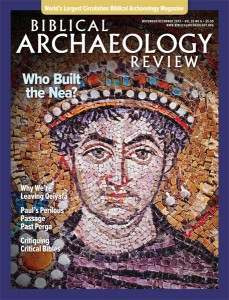An Ending and a Beginning
Why we’re leaving Qeiyafa and going to Lachish
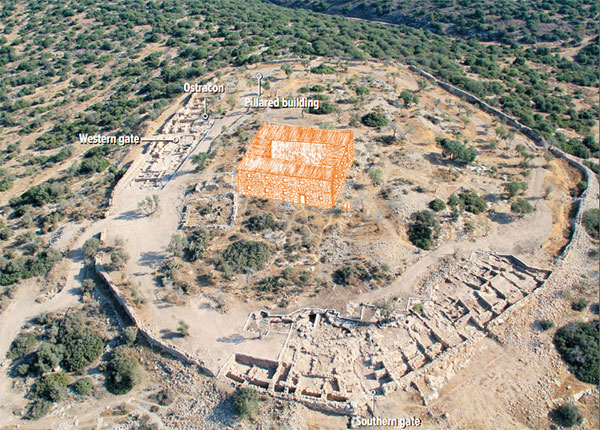
The current heated debate on the relationship between history, the Bible and archaeology focuses on the tenth century B.C.E., the time of David and Solomon. In the early years of research, the Biblical narratives of David, Solomon and his son Rehoboam were considered an accurate historical account. Since the 1980s, however, serious doubts have been raised about this tradition. The Bible is merely a literary compilation dating from centuries later, it has been argued. According to this approach, these kings were legendary figures. Although the inscription from Tel Dan recovered in 1993 clearly indicates that David was indeed a historical figure,a it was nevertheless unclear whether he was the ruler of a large empire or only a local chieftain governing a small territory. As one critic argued, David’s kingdom was simply “500 people with sticks in their hands shouting and cursing and spitting.”1
The seven seasons of excavations at Khirbetb Qeiyafa, which we conducted from 2007 to 2013, uncovered for the first time in the archaeology of the Holy Land a fortified city in Judah from the time of King David. The date of this site (1020–980 B.C.E.) is confirmed by olive pits sent to Oxford University for radiocarbon dating.
Qeiyafa overlooks the Elah Valley, guarding the road from Philistia and the Coastal Plain to Jerusalem. At this time the nearby Philistine city of Gath (8 miles to the west) was a hundred-acre urban center. No doubt it tried to expand its influence to the east, toward Judah. It could not be a coincidence that exactly at this location and exactly at this time, the Biblical narrative places the battle of David and Goliath of Gath.
Khirbet Qeiyafa turned out to be a most exciting and productive site: An essentially one-period Iron Age site, built on bedrock, with a rich destruction layer and relevant Biblical memories. Our excavations revealed a heavily fortified city surrounded by a casemate wall,c two gates, two gate piazzas and a belt of houses adjacent to the city wall. To top it off, a monumental administrative building was uncovered on the acropolis during our 2013 season.
About 100,000 tons of stone were required for the construction of this city. The urban planning of a casemate city wall and adjacent houses is typical of a Judahite city and can be seen at later Judahite cities such as Beersheba, Tell Beit Mirsim, Tell en-Nasbeh and Beth Shemesh.
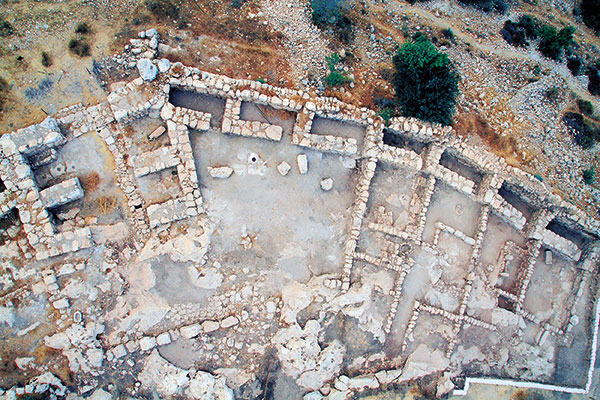
We happened on the monumental building at Qeiyafa quite by accident. Much of the central part of the site was exposed bedrock—nothing to dig. So we concentrated on the periphery of the site with its imposing wall and lines of houses. In our last season, however (why do archaeologists so often recover their most exciting finds at the end of the dig?), we decided to excavate what was left to be excavated in the central—and highest—part of the site. There we found an imposing building from the Byzantine period, 1,400 years later than the time of King David. But in the course of excavating it, we discovered that the builders of this Byzantine structure had destroyed a large part of another building that had previously existed exactly on this spot. And it was from the time of King David!
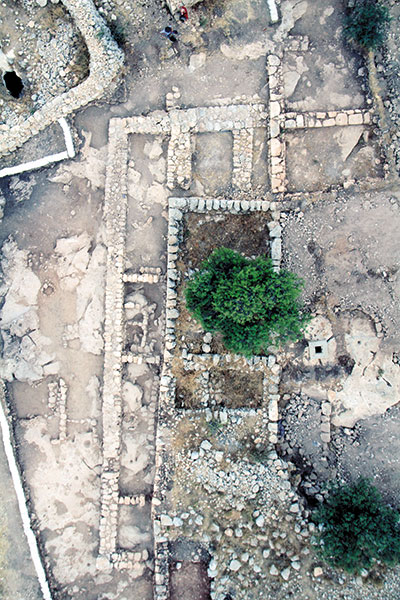
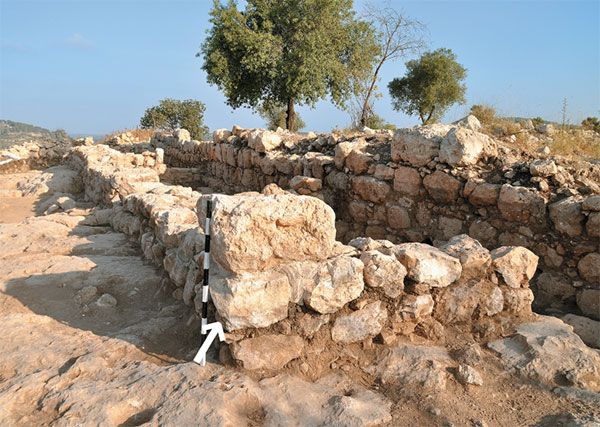
This earlier building covered more than 10,000 square feet. Its walls were three feet thick—two or three times the thickness of the walls of other buildings at the site—suggesting that the building could have supported several stories. And it occupied the highest and most important location—at the center of the site, overlooking the entire city as well as the surrounding countryside as far as Jerusalem and the Hebron mountains to the east and Ashdod to the west. This huge structure was both a prominent and potent point of the city. It reflects power and authority over the city, as well as the region. We believe it was an administrative center of the recently established Davidic kingdom. From here the city and the region were controlled. We have called it a palace. Of course, this does not refer to the king’s house; obviously he lived in his palace in Jerusalem. But as the major administrative center on the western edge of David’s kingdom, it could have been a palatial building.
Our excavations of Khirbet Qeiyafa also produced a large assemblage of tens of thousands of pottery vessels, hundreds of stone vessels (some made of basalt and alabaster), more than 40 metal weapons, rich cultic paraphernalia (see forthcoming article in BAR), Egyptian scarabs and seals and inscriptions. The prize find, of course, was the ostracon discovered in 2008 with five lines of the oldest known Hebrew text ever discovered—a thousand years older than the Dead Sea Scrolls.d

In addition, in 2013 we also uncovered a pillared building near the northern part of the site. Dozens of these pillared buildings, which likely functioned as storage facilities or markets, have been found at sites along Iron Age trade routes in Israel.e Similar structures have been uncovered at Hazor, Megiddo, Beth Shemesh, Beer-Sheva and elsewhere. Other similar structures contemporaneous with the Qeiyafa building have been found at Geshurite, Canaanite, Philistine and Amalekite sites; the newly discovered pillared structure at Khirbet Qeiyafa is the earliest-known example at an Israelite or Judahite site.

What was the ancient name of Khirbet Qeiyafa? We suggest that it was the Biblical site of Sha’arayim, mentioned twice as located in the Valley of Elah, twice connected with David and specifically as part of the David and Goliath story in 1 Samuel 17:52. The name Sha’arayim means “two gates,” and indeed Khirbet Qeiyafa had two gates, a phenomenon not found in any other small city of this period.
Khirbet Qeiyafa redefined the debate over the early kingdom of Judah. It is clear now that David’s kingdom extended beyond Jerusalem, that fortified cities existed in strategic geopolitical locations and that there was an extensive civil administration capable of building cities. The inscription indicates that writing and literacy were present and that historical memories could have been documented and preserved for generations.
Indeed, Khirbet Qeiyafa supplies us with rich data on the early tenth century B.C.E. If we were excavating for a few more seasons, we would probably find additional data from this time period. However, we have already excavated over 25 percent of the site, which is five to ten times more than the percentage at any other tenth-century B.C.E. site excavated in all of Israel. About 30 percent of the area inside Khirbet Qeiyafa is simply exposed bedrock; therefore not much is left to be excavated. Moreover, it is always important to leave areas for future excavations that will probably have better techniques and newer methods. It is time to close shop.

But even more important: Where do we go from here? It is time for us to investigate new research questions. While we have a great deal of data on the early tenth century B.C.E., we know very little about the second half of this century.
The kingdom of Judah existed for about 400 years (c. 1000–586 B.C.E., the date of the Babylonian destruction). Its capital was Jerusalem in the hill country. The second most important city in the kingdom was Lachish in the Shephelah,f a two-day walk from Jerusalem. Thus, investigations in Lachish should give us clear answers regarding the early development of the kingdom of Judah. We already know about the glory of Lachish at the time of King Hezekiah, at the end of the eighth century B.C.E., when it was under Assyrian siege and destroyed in 701 B.C.E. This well-known event is mentioned in three Biblical books (2 Kings 18; Isaiah 36–37; 2 Chronicles 32), documented in Assyrian annals and depicted on a monumental relief from Sennacherib’s palace at Nineveh.g This relief is now on display in London’s British Museum.
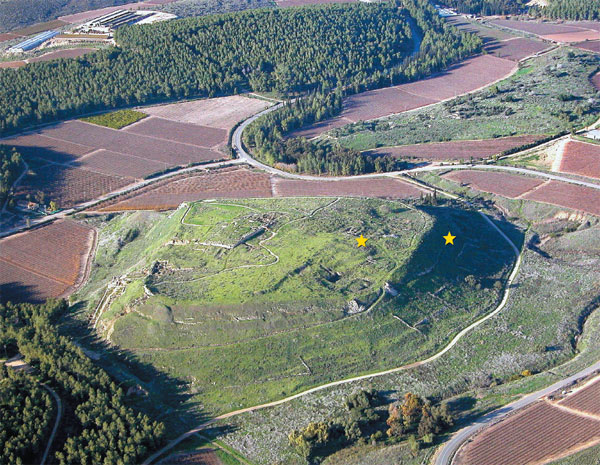
Three previous expeditions excavated at Lachish. The first was British in 1932–1938, directed by James Leslie Starkey and his assistant Olga Tufnell. The second was an Israeli expedition directed by Yohanan Aharoni of Tel Aviv University for two seasons in 1966 and 1968. The third expedition, under the superb direction of David Ussishkin of Tel Aviv University, took place between 1974 and 1987. The Starkey-Tufnell and Ussishkin expeditions set new standards in excavation and publication. They revolutionized our understanding of various aspects of Lachish, such as the later history of Judah and the pre-Israelite Late Bronze Age Canaanite city.
Sennacherib conquered the Judahite city of Lachish at its zenith in the Iron Age, a period represented by Level III. However, there are two earlier Iron Age levels at Lachish: Level IV and, below it, Level V. These two layers are not as well known because the previous expeditions to Lachish did not investigate them extensively. They were unearthed only in very limited exposures, creating a lacuna in the archaeological record of southern Judah.
The fourth expedition to Lachish is a joint project of the Institutes of Archaeology at the Hebrew University of Jerusalem and the Southern Adventist University in Tennessee, together with other consortium institutions. We are privileged to have David Ussishkin as a scientific advisor to the project. The main targets of our new expedition to Lachish are Level IV and Level V. These two layers can tell us how Judah developed from its beginnings into the full-fledged state destroyed by Sennacherib in 701 B.C.E. Our expedition will try to answer questions like: When was Lachish inhabited for the first time in the Iron Age? When was Lachish first fortified in the Iron Age? How did the economy, administration, international connections, writing, cult and art develop in the first 200 years of the kingdom of Judah? We will also examine the connection between archaeology and the Biblical narrative of the tenth century B.C.E. According to 2 Chronicles 11:5–12, Rehoboam, the son and successor to Solomon, fortified Lachish together with several other cities in Judah. Was there a fortified city from this period in Lachish? These are the principal questions that bring us back to Lachish, the most important city of Judah after Jerusalem.
Where at Lachish should we dig? Although the central and southern areas at Lachish have been extensively examined, no substantial remains were uncovered from Level IV and Level V. Where can we excavate so that these layers will be found in our trenches? The great city of Layer III covered an area of nearly 20 acres. The earlier cities were probably much smaller and may have been spread over an area of only 5 or 6 acres.
When Yohanan Aharoni excavated in the northeast part of the site, he found some impressive architecture and some rich finds from Levels IV and V. Thus, we decided to examine the northeast quarter of the site as our first step. During five days in late July 2013, with an expedition of about 30 people, we examined three spots in the northeast part of the tell. The southernmost spot is adjacent to Yohanan Aharoni’s excavation. After clearing the topsoil, we exposed a rich Level II conglomeration from the end of the First Temple period (586 B.C.E.). In a limited area we found a group of complete pottery vessels, including a rare type of jug decorated with red paint.
Further to the north, inside a large round depression, we excavated one square and went down a little more than 7 feet. No architecture or floor levels were found, only two layers of fill. In the upper fill we recovered relatively large quantities of pottery sherds, while only a few were found in the lower part of the fill. In the end we backfilled this square. The character of the human activity in this area is unclear. David Ussishkin has suggested that the large round depression was created in 701 B.C.E. when soil was removed to build a counter-ramp inside the city to protect it from the Assyrian siege ramp outside the city. Saar Ganor conjectures that a water system may have been dug here, down to the water table. We are considering conducting a geophysical survey, which might reveal more about this enigmatic feature at Tel Lachish.
At the northeast corner of Lachish, adjacent to what may be a deep well, we examined the fortification systems on the slope. This part of the site is closest to the river and features a path leading to the top of the tell. This is an ideal location for a city gate. In the 1930s the British expedition excavated this slope and uncovered some massive walls. However, the results of this operation were never published. We cleaned the vegetation and re-exposed a number of massive stone walls. The area exhibits a complex history of building and rebuilding. We would like to enlarge our “spot” and excavate deeper to get a complete sequence of the Iron Age history of the site, from Level II to Level V.
In the summer of 2014 we will have a six-week season and a larger expedition that may supply answers to some of these questions.
The results from Khirbet Qeiyafa, together with the results from Lachish, will enable us to obtain a clearer and more complete picture of the early history of the kingdom of Judah in the tenth and ninth centuries B.C.E. We view these two excavations as one regional project.
True, an article could be written that Judah became a state only at the end of the eighth century B.C.E., or at the end of the ninth century B.C.E. or at any other hypothetical date that lacks solid data. We work differently. We look for data first. We base our dating only on radiometric, objective measurements. We base our ethnic identification on animal bones, pottery, cult objects and urban planning. We are open-minded to any new find, and we do not need to keep supporting 30-year-old incorrect hypotheses. Our method takes time: years of hard labor in the hot summers of the Near East and years for the restoration and analysis of the finds. But when all this is completed, our research results will be based on solid physical evidence.
This work is made possible thanks to the hundreds of young and older volunteers who join us every year. For 2014 on, all are welcome to join this fascinating new project in the most fascinating Biblical city of Lachish.

